

Even though it doesn’t hold very well to the cold, allamanda is a plant that perfectly decorates Mediterranean-type gardens.
Key Allamanda facts
Name – Allamanda cathartica
Family – Apocynaceae
Type – climbing vine
Exposure – full sun
Soil – rather light
Foliage: evergreen – Flowering: July to November
This spectacular trumpet vine bestows us with sumptuous yellow blooming all summer long.
The planting of an allamanda is an important step, even though it cannot be planted outdoors everywhere. Planting in a pot is an option in some cases.
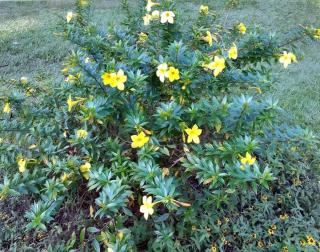
If you live in mild climates, plant it in spring in light soil.
Indeed, wind tends to dry plants out, and Allamanda is vulnerable to air that is too dry.
Additionally, as a precaution against transplant shock, cover it with a shade veil for 2-3 weeks just after planting, if the weather is very hot. Later on, this isn’t necessary.
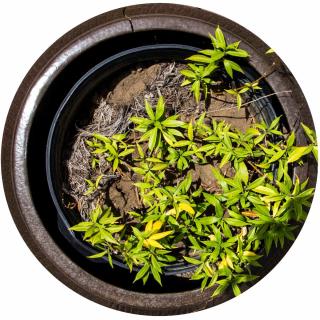
To winterize your allamanda, simply bring your potted vine in a well-lit place where it doesn’t freeze over winter.
You can prune it beforehand to make it easier to handle and move around. As you’ll see right below, Allamanda will survive all the pruning woes you subject it to, so don’t hold back!
Allamanda takes pruning well, it even helps it grow stronger.

Allamanda is an easy plant to grow when in the proper environment.
Allamanda cherishes moisture and needs watering in case of heat waves. But don’t forget that the root area must drain well or the roots will rot!
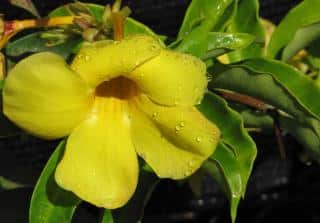
In particularly dry areas, find ways to increase air moisture in the vicinity of the plant. A nearby fountain or bird bath could do the trick outdoors.
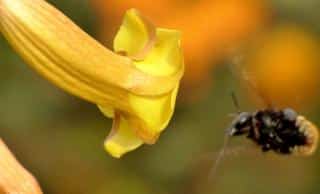
If leaves turn brown and curl, most probably aphids are colonizing the plant.
This vine is also vulnerable to red spider mite attacks.
Luckily, it’s also a favorite of pollinators, attracting bees, butterflies and even birds to the garden.
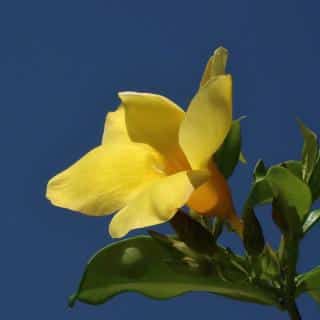
It illuminates the garden with its bright yellow flowers.
When placed in full sun, for instance on the edge of a deck, it spreads a delicate fruity fragrance.
All the parts of the plant induce skin photosensitivity. This means they make skin more vulnerable to irritation due to ultra-violet rays. Handle it with gloves to avoid this toxicity.
Furthermore, ingesting the plant causes nausea and vomiting.
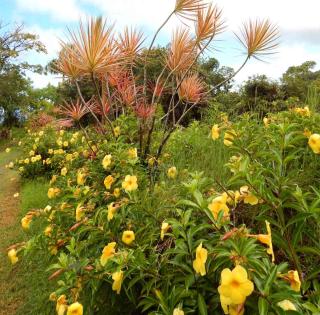
Nonetheless, even simply to decorate a mound of dirt, the golden trumpet vine produces beautiful results.
Judge for yourself, here with a beautiful red Dracaena marginata!
To produce spectacular blooms, add special organic flower plant fertilizer from spring to summer.
I planted my allamanda in a pot (first year planting them). I live in Ohio and I know I have to bring them in for the winter. Do I cut them back to a certain height? I was planning on bringing them into my basement near a window, is that the right thing to do?
Hi Michana, yes that is exactly what you need to do. Go ahead and cut it back to a manageable height. I added a few sentences describing how to winterize the plant, in the section on potted alamanda.
I bought allamanda seven days ago and now it is in bloom. The first day I bought it, I sprayed it with fertilizer, and then I watered it once a day with clean water. Recently, there are more rainy days than sunny days. Its leaves are rolled up and flowers dropped. No aphids and red spider pests. I wonder what I need to do now to save it?
Hi Rosy, sorry it took a while to answer. It seems to me that the plant is simply undergoing transplant shock. It’s normal for it to adjust when moving. It doesn’t get that perfect light as it did in the nursery anymore, perhaps they even had supplemental lighting set up.
Flower drop is normal in this case. Leaves rolling up a little less common but still understandable. What it loves above all is well-draining soil. If you feel the soil is always soggy, it won’t help the plant settle in. Only water when it feels dry, or when it’s been 5-6 days since the last rain/watering.
I inherited a beautiful purple allamanda from the last owner of our house. It was planted next to our screen on our lanai and it is so vigorous I have had to cut it. Any ideas how I can support it so close to the house?
Hi Janet, it definitely needs a strong, sturdy lattice. Also possible is a stainless-steel wire set, with studs that you bolt into the wall.
I have 2 allamandas planted in my backyard. They have grown so much and have been so beautiful all spring, summer and early fall. I am in the Houston, Texas area and I’m not sure what to do with them in the winter. If we get temps below 40 can I cover them so they won’t freeze. I might need to trim then back some before covering them due to the size. Is this going to be ok.
Hello Carol, for sure it’s possible to trim them now, especially since necessity calls. Recommendations of pruning late in winter are mostly to guide the plant along for it to grow in desired directions before the growth spurt starts. It’s a good idea to protect them with some cover when temps near freezing to give them a strong chance. Monitor weather forecasts so you can anticipate a bit, and practice at least once beforehand so you’re quick at it and don’t suffer in the cold weather yourself. Lastly, consider adding some mulch around the base, extending it to cover the root areas, this’ll help, too.
Thank you Gaspard for the reply. I did not repot the plant, I kept it in the same pot. Initially the leaves started turning yellow and droopy so I started giving less water but after that the leaves just dried and become crisp. Slowly all leaves fell off. Now its just stems in the pot. I plan to keep the plant in the pot itself.
Ok then! I’m sure if you follow these tips you’ll be giving your plant good survival chances. Check if there’s still life in it by breaking off a twig or side stem and looking for a fresh green color under the bark.
I purchased fullly grown allamanda in 10 inch pot a month back, kept it in sun and regularly watered. Temperature has been around 30-40 degree C but all the leaves have dried and plants seems to not reviving. Please help what should I do to revive it?
Hmmm, it sounds a lot like transplant shock to me. What I suspect is that in the nursery, the plants were very well watered, in normal amounts but possibly up to three times a day (especially in hot weather). Their 10-inch pot is a good size, but it won’t keep much water if the plant is thirsty. To have a chance of saving your allamanda, try the following:
– if you plant to transfer it to the ground, do it quickly so that roots can start spreading to look for more water. Check out our tips on planting shrubs.
– if your goal is to keep them in pots, then repot into a larger-sized pot, 12″ or 14″ (30 to 35 cm). In the soil mix, add hydrogel crystals to serve as a water reserve.
In both cases, if possible, water twice or thrice a day for at least a month, to give the plant time to grow new roots. Follow a few of these ideas to minimize transplant shock, such as extending a shade veil to block out most of the sun, or using mulch to reduce water evaporation.
At this stage, don’t remove leaves or dead twigs yet. Not only might some of them revive, but having the leaves and twigs up there will help retain some air moisture for the season. Later on, you’ll prune what definitely looks dead away.